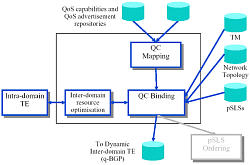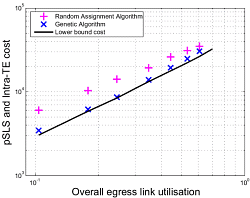The
results of Offline Inter-domain TE can be divided into three areas.
 In
the first area, we have applied an evolutionary Genetic Algorithm
(GA) to solve offline traffic engineering problems that are based
on the MESCAL QoS model. Our model works on a traffic matrix that
includes delay and bandwidth as QoS parameters. The algorithm finds
near-optimum assignments of traffic matrix aggregate flows to intra-domain
resources (represented by an l-QC) and inter-domain resources (represented
by a pSLS, that is, an o-QC offered by a downstream domain) in such
a way as to minimise the total cost to the domainís INP. In
the first area, we have applied an evolutionary Genetic Algorithm
(GA) to solve offline traffic engineering problems that are based
on the MESCAL QoS model. Our model works on a traffic matrix that
includes delay and bandwidth as QoS parameters. The algorithm finds
near-optimum assignments of traffic matrix aggregate flows to intra-domain
resources (represented by an l-QC) and inter-domain resources (represented
by a pSLS, that is, an o-QC offered by a downstream domain) in such
a way as to minimise the total cost to the domainís INP.
 We
have compared the GA with a random assignment algorithm (effectively
representing current day best-effort inter-domain traffic engineering
practices applied to a QoS-aware environment), and a brute force
assignment algorithm. We have shown that in a simplified validation
scenario the genetic algorithm obtains results that are close to
an analytically obtainable lower bound solution. We have also demonstrated
that in more complex scenarios the GA can be used to obtain offline
QoS-aware traffic engineering solutions that are of significantly
lower cost than a random approach. We
have compared the GA with a random assignment algorithm (effectively
representing current day best-effort inter-domain traffic engineering
practices applied to a QoS-aware environment), and a brute force
assignment algorithm. We have shown that in a simplified validation
scenario the genetic algorithm obtains results that are close to
an analytically obtainable lower bound solution. We have also demonstrated
that in more complex scenarios the GA can be used to obtain offline
QoS-aware traffic engineering solutions that are of significantly
lower cost than a random approach.
In our second area, we have developed three heuristic algorithms
to solve the integrated inter-domain / intra-domain TE problem for
a traffic matrix in which bandwidth is used as the QoS parameter.
Simulation results show that the Greedy-penalty performs better
than the other two algorithms in terms of total network bandwidth
consumption.
In
the third area, we have explored the relationship between intra-domain
and inter-domain TE, and explored the interaction between them by
proposing and analyzing both a decoupled and integrated approach.
We have shown through simulation how the integrated approach results
in lower cost TE solutions with lower total consumed bandwidth than
the decoupled approach.
Further
reading:
M.P.
Howarth, M. Boucadair, P. Flegkas, N. Wang, G. Pavlou, P. Morand,
T. Coadic, D. Griffin, A. Asgari and P. Georgatsos, "End-to-end
quality of service provisioning through Inter-provider traffic engineering,"
to appear in Computer Communications, Elsevier, end 2005.
K.H.Ho,
M. Howarth, N. Wang, G. Pavlou and S. Georgoulas, "Two Approaches
to Internet Traffic Engineering for End-to-end Quality of Service
Provisioning," poster in Proc. 1st EuroNGI Conference
on Next Generation Internet Networks - Traffic Engineering, Rome,
Italy, 18-20 April 2005. [link]
K.
Ho, N. Wang, P. Trimintzios, G. Pavlou, M.P. Howarth, "On Egress
Router Selection for Inter-domain Traffic with Bandwidth Guarantees,"
Proc. IEEE Workshop in High Performance Switching and Routing (HPSR'2004),
Phoenix, Arizona, USA, IEEE, 18-21 April 2004. [link]
MESCAL
deliverable D1.3, "Final specification of protocols and algorithms
for inter-domain SLS management and traffic engineering for QoS-based
IP service delivery", Chapter 10, section 10.4. [link]
MESCAL
deliverable D3.2, "Final experimental results: validation and
performance assessment of algorithms and protocols for inter-domain
QoS through service-driven traffic engineering", Chapter 3,
section 3.1. [link] |